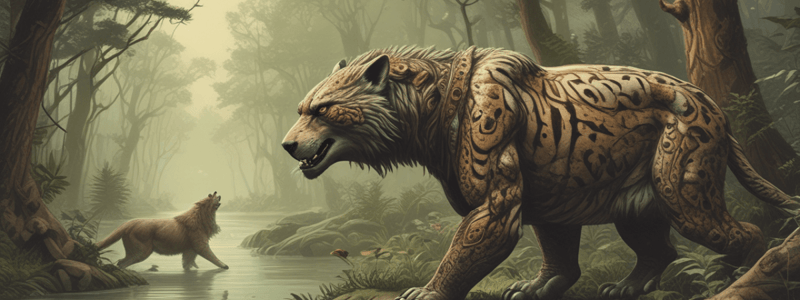Podcast
Questions and Answers
What is the primary purpose of camouflage in predators?
What is the primary purpose of camouflage in predators?
- To warn prey of their presence
- To attract potential mates
- To communicate with other predators
- To blend in with the environment for hunting (correct)
Which adaptation involves the use of specialized body coloration to warn group members of dangerous predators?
Which adaptation involves the use of specialized body coloration to warn group members of dangerous predators?
- Offensive techniques
- Mimicry
- Communication techniques
- Warning coloration (correct)
How do Honeybees warn others in the hive of predators?
How do Honeybees warn others in the hive of predators?
- By releasing chemicals
- By vibrating (correct)
- By stomping their feet
- By using specialized body coloration
What is an example of an offensive technique employed by prey?
What is an example of an offensive technique employed by prey?
In coevolution, why do species evolve in response to evolutionary changes in each other?
In coevolution, why do species evolve in response to evolutionary changes in each other?
What is the key difference between a predator and prey?
What is the key difference between a predator and prey?
What is the process of hunting to capture and eat organisms known as?
What is the process of hunting to capture and eat organisms known as?
Which statement is true about predators?
Which statement is true about predators?
What type of predator is a zebra, according to the text?
What type of predator is a zebra, according to the text?
What must prey organisms acquire to survive predation?
What must prey organisms acquire to survive predation?
Flashcards are hidden until you start studying
Study Notes
Predator-Prey Interactions
- Predator-prey interactions are built around the concept of coevolution, where the fitness of two different species is tightly linked, and they evolve in response to evolutionary changes in each other.
- Coevolution leads to a constant adaptation of predators and prey to survive and outcompete each other.
Predator Adaptations
- Camouflage is a common adaptation used by predators, where they use body shape and coloration to blend in with their environment.
- Example: polar bears use their white fur to blend in with snowy environments, making it easier to capture prey.
Prey Adaptations
- Camouflage is also used by prey to avoid predators, by blending in with their environment.
- Example: deer use their brown fur and spots to blend in with wooded environments.
- Communication techniques are used by prey to warn each other of predators, such as:
- Vervet monkeys using vocalized signals for different types of predators.
- Honeybees using vibrations to warn others in the hive.
- Prairie dogs stomping their feet to warn others of predators.
- Offensive techniques are used by prey to protect themselves, such as:
- Skunks spraying chemicals to ward off predators.
- Cactus plants having spikes to prevent being eaten by predators.
- Warning coloration is used by prey to signal to predators that they are toxic or dangerous, such as:
- The strawberry poison dart frog's bright red color to warn predators that it is toxic.
- Mimicry is used by prey to resemble another species that is toxic or dangerous to predators, such as:
- Batesian mimicry, where a harmless organism mimics the warning coloration of a harmful species.
Predator vs. Prey
- Predator-prey interactions are a key component of the structure of ecosystems.
- Predators are organisms that capture and eat other organisms, while prey are the organisms being captured and eaten.
- Types of predators can include both carnivores and herbivores.
- Types of prey can include both animals and plants.
Examples of Predator-Prey Interactions
- Lion and zebra: the lion is a carnivorous predator, while the zebra is the prey.
- Zebra and grass: the zebra is an herbivorous predator, while the grass is the prey.
- Polar bear and prey: the polar bear uses camouflage to capture prey in the snowy environment.
Studying That Suits You
Use AI to generate personalized quizzes and flashcards to suit your learning preferences.




